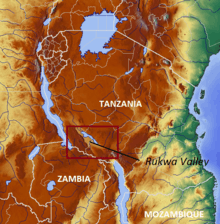Rukwa Valley
The Rukwa Valley is a valley of southwestern Tanzania, and is a part of the Great Rift Valley.[1] Sparsely populated because of its harsh environment,[2] its grassland biodiversity includes thousands of species.

Geography

The valley lies at an elevation of 2,600 feet (790 m) above sea level. It is located between Lake Nyasa and Lake Tanganyika. Its low southeastern edge includes the shallow, alkaline Lake Rukwa, which is fringed by the North and Central Rukwa plains. The valley is to the northwest of Mbeya, and stretches as far as Karema and the Luakuga Gap.[3] It is bounded to the east and west by high escarpments,[4] 25–30 miles (40–48 km) apart. The Rukwa Rift is 30 miles (48 km) wide and 200 miles (320 km) in length.[5] The valley also includes the Kafufu, the Myakaliza, the Magamba, the Ambala and the Luhumuka Rivers.[6]
Climate
Seasonal differences are extreme.[7] The Rukwa's location within the tropics accounts for its one rainy season.[5] Rainfall occurs during the months of November through April, and can vary between 20–40 inches (510–1,020 mm). Because of the only slight variations in grade, flooding is common. Conversely, the dry months of May through October are arid, and in comparison to the cooler Ufipa Plateau, the valley is hot.[8]
Wildlife
There are three main flora zones in the Rukwa Valley: the treeless grass plains, a belt of open woodland, and the escarpment area.[5] Valley grassland and wooded grassland are differentiated by the illuvial soil of the former and the colluvial soil of the latter.[7] The woodland is partly covered by acacia.[9] The northern end of Lake Rukwa encompasses a wetland of papyrus and reed.[10]
The grasslands are inhabited by a rich biodiversity of thousands of species and a rich variety of birds.[4][11] It has a significant population of topi in particular and some groups of some 1500 have been reported in clusters in the valley.[12] Estimates in the 1950s were that some 3000-4000 topi roamed the land around Lake Rukwa.[12] The abundant grassland in the valley has been described a "mecca for grazers".[13] Several mutations have been reported in the valley including an albino giraffe and a dark coloured zebra "marked with spots instead of stripes".[14] Other game animals include eland, reedbuck, and buffalo.[5] The valley is home to some rare animals, including poku and Shoebill.[1] In 1939, A. Lea and Dirk van Velden Webb noted a relationship between locusts and the valley's grassland.[7] Lake Rukwa, which has no outlet, contains a large crocodile population.[15] The Uwanda Game Reserve, Rukwa Game Reserve and Lukwati Game Reserve are amongst the protected areas in the valley.
Population
The Rukwa is sparsely populated, with an economy revolving around agriculture, cattle keeping and fishing. An important rice-producing area, the main crops are maize and paddy. Garden crops include beans, pumpkins, and sweet potatoes; bananas, mangoes, lemons, pineapples, sesame, and sugar cane are grown as well.[5] There is an influx of Sukuma cattle.[9] Human cases of anthrax was noted in 1985 to be a "persistent problem" stemming from cattle consumption.[16]
References
- Yanda, Benjamin Chad; University of Wyoming. Dept. of Geography (2004- ) (2007). A political ecology of land use change and natural resource conflict in the Rukwa Valley, southwestern Tanzania. ProQuest. pp. 20–. ISBN 978-0-549-26383-8. Retrieved 31 March 2012.
- Chambers's Journal. W & R Chambers. 1954. pp. 157–8. Retrieved 31 March 2012.
- John Edward S. Moore (1903). The Tanganyika problem: an account of the researches undertaken concerning the existence of marine animals in Central Africa. Hurst and Blackett, limited. p. 73. Retrieved 31 March 2012.
- Zoological Society of London (1965). Proceedings of the Zoological Society of London. Longmans, Greens. p. 305. Retrieved 31 March 2012.
- Pielou, E. C. (October 1952). "Notes on the Vegetation of the Rukwa Rift Valley, Tanganyika E. C. Pielou". Journal of Ecology. British Ecological Society. 40 (2): 383. doi:10.2307/2256807. JSTOR 2256807.
- Tanganyika. Geological Division. Short Paper. Retrieved 31 March 2012.
- Dean, G. J. W. (May 1967). "Grasslands of the Rukwa Valley". Journal of Applied Ecology. British Ecological Society. 4 (1): 45–57. doi:10.2307/2401408.
- South Africa. Dept. of Agriculture (1939). Science bulletin. p. 59. Retrieved 31 March 2012.
- "Welcome to the Rukwa". rukwa.go.tz. Retrieved 31 March 2012.
- "TZ033 Lake Rukwa". BirdLife International. Retrieved 31 March 2012.
- Vesey-Fitzgerald, D. (1973). East African Grasslands. East African Pub. House. pp. 43–. Retrieved 31 March 2012.
- Zoological Society of London (1965). Transactions of the Zoological Society of London. Published for the Zoological Society of London by Academic Press. p. 186. Retrieved 31 March 2012.
- Camerapix (1998). Spectrum Guide to Tanzania. Interlink Books. p. 197. ISBN 978-1-56656-234-8. Retrieved 31 March 2012.
- Williams, John George (1967). A field guide to the national parks of East Africa. Collins. pp. 130–1. Retrieved 31 March 2012.
- Fitzpatrick, Mary (1 May 2008). Tanzania. Lonely Planet. pp. 296–. ISBN 978-1-74104-555-0. Retrieved 31 March 2012.
- Webber, RH (October 1985). "Anthrax in Lake Rukwa Valley, Tanzania: a persistent problem". J Trop Med Hyg. 88 (5): 327–31. PMID 3836310.